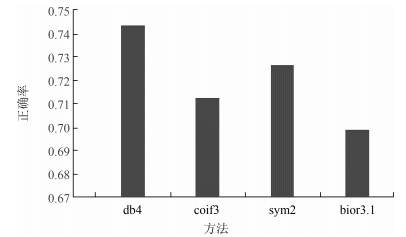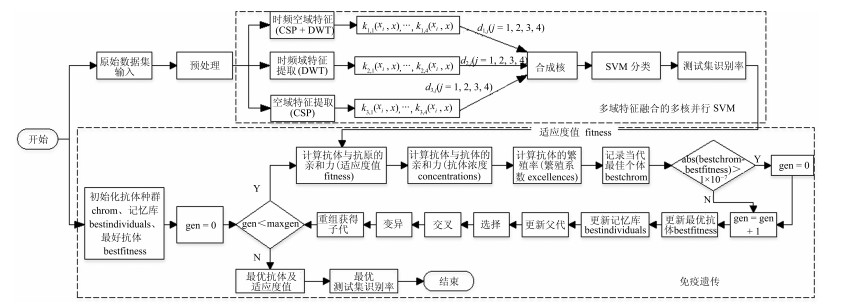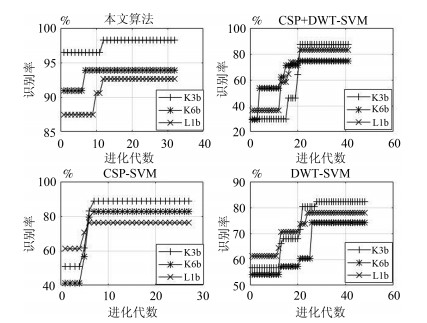Motor Imagery EEG Classification Based on Immune Multi-domain-feature Fusion and Multiple Kernel Learning SVM
-
摘要: 针对多通道四类运动想象(Motor imagery, MI)脑电信号(Electroencephalography, EEG)的分类问题, 提出免疫多域特征融合的多核学习SVM (Support vector machine)运动想象脑电信号分类算法.首先, 通过离散小波变换(Discrete wavelet transform, DWT)提取脑电信号的时频域特征, 并利用一对多公共空间模式(One versus the rest common spatial patterns, OVR-CSP)提取脑电信号的空域特征, 融合时频空域特征形成特征向量.其次, 利用多核学习支持向量机(Multiple kernel learning support vector machine, MKL-SVM)对提取的特征向量进行分类.最后, 利用免疫遗传算法(Immune genetic algorithm, IGA)对模型的相关参数进行优化, 得到识别率更高的脑电信号分类模型.采用BCI2005desc-Ⅲa数据集进行实验验证, 对比结果表明, 本文所提出的分类模型有效地解决了传统单域特征提取算法特征单一、信息描述不足的问题, 更准确地表达了不同受试者个性化的多域特征, 取得了94.21%的识别率, 优于使用相同数据集的其他方法.Abstract: For the classification problem of four kinds of multi-channel motor imagery (MI) EEG, a multi-class motor imagery EEG classification algorithm based on immune multi-domain-feature fusion and multiple kernel learning SVM is proposed. Firstly, discrete wavelet transform (DWT) is used to extract the time-frequency features of EEG signals. The spatial features of EEG are extracted by using one versus the rest common spatial patterns (OVR-CSP). And then time-frequency and spatial features are fused to form one-dimensional feature vector. Secondly, multiple kernel learning support vector machine (MKL-SVM) is used as a classifier to classify the feature vectors. Finally, immune genetic algorithm (IGA) is used to optimize the parameters of MKL-SVM. The experimental results on BCI2005desc-Ⅲa dataset show that the classification model proposed in this paper not only effectively overcomes the shortcomings that is the traditional single-domain feature extraction algorithm is lack of information description, but also more accurately expresses the multi-domain characteristics of different subjects. It achieves a recognition rate of 94.21%, which is better than other methods of using the same data set.
-
Key words:
- Discrete wavelet transform /
- common spatial patterns /
- multiple kernel learning support vector machine /
- immune genetic algorithm /
- motor imagery /
- electroencephalography
-
随着计算机技术和脑科学的发展, 人们开始尝试构建一种大脑与外界的交流通路, 此通路不依赖外周神经和肌肉组织的参与, 能将大脑信号解读成相应的命令来实现与外部世界的交流和控制, 此通路被命名为脑—机接口(Brain computer interface, BCI)[1]. BCI这种人与外界交流通路, 在康复工程与智能辅助机器人上的应用也引起了人们的重视[2], 但是脑-机接口是一项多学科交叉技术, 其关键在于如何有效、准确地对脑电信号进行特征提取和分类[3].目前, EEG特征提取主流算法包括时域特征提取(自适应自回归模型[4])、频域特征提取(小波包分解[5])、空域下特征提取(公共空间模式[6])等; 分类方法包括线性分类器、支持向量机[7]和神经网络[8]等.
脑电信号的识别过程一般是先对原始信号进行预处理, 然后采用上述算法进行特征提取, 再使用相关分类算法进行模式识别. BCI系统利用此方法, 取得了良好的分类效果, 但对于运动想象脑电信号的识别, 上述方法仍然存在脑电信号特征单一、信息描述不足、对多维脑电数据适应度低、识别精度低等问题[9].
针对以上问题, 本文提出结合免疫遗传优化算法和多域特征融合的多核学习支持向量机模型, 有效地解决了单域下特征信息描述不足的问题.离散小波分析具有时、频同时局部化的优点, 能将信号能量强度或密度的变化在时、频域上同时表示出来, 有利于更直观地观察与分析; 公共空间模式能有效地表现出两类特征在空域的差异, 但是对于多类运动想象信号的识别, 仍然存在识别率低下的问题, 文献[10]利用公共空间模式分别对两类和四类运动想象信号进行分类, 两类的正确率高达97%, 四类最好为79%.多核学习支持向量机有效解决了多类运动想象脑电信号识别精度低的缺陷.不同高斯核分别对应多个不同域下的特征, 每个核具有一个权系数, 每个权系数能够在训练中, 通过梯度下降自适应地学习到最优的值, 使得模型具有更好的鲁棒性和分类性能, 克服单核学习中对单域特征的依赖.同时利用免疫遗传算法优化模型中的相关参数.实验结果表明, 本文提出的免疫多域特征融合多核学习支持向量机的多类运动想象脑电信号分类算法提高了多类运动想象脑电信号的识别率.
1. 运动想象脑电信号多域特征提取
1.1 运动想象脑电信号时频域特征提取
离散小波变换(Discrete wavelet transform, DWT)提取运动想象脑电信号的时频域特征.离散小波变换具有良好的时频局部化和多分辨率特性, 能够在多尺度下将信号分解为低频尺度空间和高频细节空间并提取出信号中的特征点, 如时频域内的突变点和拐点[11], 其实质是将信号分解成一系列小波函数的叠加, 小波窗口的大小随频率改变; 低频时, 具有时间分辨率低、频率分辨率高的特点; 高频时, 具有时间分辨率高、频率分辨率低的特点, 正是这些多分辨率的特点使得小波分析很适用于提取脑电这种非平稳信号的特征.
利用离散小波变换分析原始EEG信号时, 选择合适的分解层次以及小波函数尤为重要.
分解层次是依据信号的采样率以及所需EEG信号的频率来确定. $\alpha$波(8 Hz$\sim$13 Hz)和$\beta$波(14 Hz$\sim$30 Hz)被公认为是反映多类运动想象EEG信号特征的频段, 所以只需提取8 Hz$\sim$30 Hz的信号特征.本文使用的EEG信号数据的采样频率为250 Hz, 则DWT分解后不同层次所对应的频率信息如表 1所示:
表 1 DWT分解250 Hz采样频率所对应各层的频率Table 1 Frequencies corresponding to different levels of DWT decomposition with a 250 Hz sampling rate分解信号 频率范围(Hz) A1 0$\sim$62.5 D1 62.5$\sim$125 D2 31.25$\sim$62.5 D3 15.625$\sim$31.25 D4 7.8125$\sim$15.625 可知, $\alpha$波和$\beta$波主要集中在D3、D4子频带中.因此选择进行4层小波分解.为进一步降低通过DWT提取的特征维数, 提升算法的实时性, 根据脑电信号在C3、C4、Cz通道出现的事件相关同步(Event-related synchronization, ERS)和事件相关去同步(Event-related desynchronization, ERD)现象[12], 在脑电信号模式识别领域, 此现象称为对EEG进行信号处理和特征提取的最根本的依据.同时此现象也会存在于此三个电极的周围电极, 不过会随着距离此三个电极的渐远而减弱.因此选择此三个电极进行时频域特征提取, 不仅能够提取出大部分脑电信号的特征, 而且减少特征的维数, 提高时效性.对此三个通道的EEG信号进行DWT特征提取, 而且在此基础上进行统计学处理, 分别以细节分量cD3、cD4系数的均值、能量均值、以及均方差作为EEG信号的时频特征.令$x_{j, k}^i\in {\bf R}^{1\times n}$表示$C_i$导的EEG信号的第$j$层细节分量系数, 其中$i=3, 4, 5$代表C3、C4、Cz电极, $j=3, 4$代表细节分量cD3、cD4, $k=1, 2, 3, \cdots, n$表示时间平移量.其均值定义为: $\bar{u}_j^i=\frac{1}{n}\sum\nolimits_{k=1}^n {x_{j, k}^i}$; 能量均值定义为: $\bar{E}_j^i=\frac{1}{n}\sum\nolimits_{k=1}^n {(x_{j, k}^i)^2}$; 均方差为: $S_j^i=\sqrt{\frac{1}{n}\sum\nolimits_{k=1}^n{(x_{j, k}^i-\bar{u}_j^i)^2}}$.因此, 每个EEG样本所具有的时频特征大小是$1\times18$.
小波基函数常用的有四种: Daubechies (db4)、Coiflet (coif3)、Symlet (sym2)、Biorthog-onal (bior3.1).分别用这4种小波函数进行18维时频特征提取, 之后使用单核SVM做分类, 其结果如图 1所示.结果表明使用db4小波基函数的识别率优于其他三种, 但总体识别率不优.
1.2 运动想象脑电信号空域特征提取
一对多公共空间模式(One versus the rest common spatial patterns, OVR-CSP)提取运动想象脑电信号的空域特征.公共空间模式(Common spatial patterns, CSP)是通过矩阵的对角化, 来构建一组最优的空间滤波器进行投影, 目的是使得两类数据的方差值差异最大化, 每类数据获得具有较高区分度的特征向量.而一对多公共空间模式(OVR-CSP)[13]是将公共空间模式从对两类信号特征提取扩展到对多类信号进行特征提取, 原理是将多类中的一类看作单独一类, 剩余的其他类则归为一类, 依次计算出每"两类"的滤波器, 最终可获得与类别数目相同的滤波器个数.对四类运动想象脑电信号进行特征提取, 因此会得到四个滤波器投影矩阵.使用一对多公共空间模式对经过预处理的四类运动想象脑电信号进行空域特征提取的过程如下:
假设$X_i$为四类运动想象脑电信号, 大小为$N\times T~(T\geq N)$, $N$为采集信号的通道数, $T$为每个通道的采样点数.分别计算四类信号的归一化协方差矩阵$R_i$:
$$\begin{equation} R_i=\frac{X_iX_i^\mathrm{T}}{\mathrm{tr}(X_iX_i^\mathrm{T})}, \quad i=1, 2, 3, 4 \end{equation} $$ (1) 式(1)中, $\mathrm{tr}(X_iX_i^\mathrm{T})$为获得矩阵$X_iX_i^\mathrm{T}$的迹, $X_i^\mathrm{T}$为$X_i$的转置.接着计算混合空间协方差矩阵$R$:
$$\begin{equation} R=\bar{R_1}+\bar{R_2}+\bar{R_3}+\bar{R_4} \end{equation} $$ (2) 式(2)中, $\bar{R_i}~(i=1, 2, 3, 4)$表示第$i$类信号全部实验的平均协方差矩阵.接着对$R$进行奇异值分解, $R$可以表示为:
$$ \begin{equation} R=U_0VU_0^\mathrm{T} \end{equation} $$ (3) 式(3)中, $U_0$为$R$的特征向量, $V$为对应$U_0$的特征值矩阵.接着对特征值进行降序排列, 同时对特征向量作相同的顺序调整, 此时改变顺序后的特征值矩阵仍视为$V$, 特征向量矩阵仍视为$U_0$.接着计算白化矩阵$P$.
$$ \begin{equation} P=V^{-\frac{1}{2}}U_0^\mathrm{T} \end{equation} $$ (4) OVR-CSP算法在计算投影矩阵时, 将四类信号中的一类视为单独一类, 剩余的三类视为另一类, 假设将$i=1$视为单独一类, 则另外一类记作:
$$ \begin{equation} R_1'=R_2+R_3+R_4 \end{equation} $$ (5) 然后对新两类信号的平均协方差矩阵进行白化, 计算如下:
$$ \begin{equation} S_1=P\bar{R_1}P^\mathrm{T}; S_1'=P\bar{R_1'}P^\mathrm{T} \end{equation} $$ (6) 然后对$S_1$, $S_1'$进行奇异值分解, 则$S_1$, $S_1'$满足$S_1=U_1V_1U_1^\mathrm{T}$, $S_1'=U_1V_1'U_1^\mathrm{T}$并且$V_1+V_1'=I$.接着对特征值做降序排列, 同样调整特征向量矩阵, 再取每个特征向量矩阵中的前$m$个特征向量来组成新的特征向量矩阵$U_1'$, 可得到滤波器投影矩阵:
$$ \begin{equation} SF_1'=(U_1')^\mathrm{T}P \end{equation} $$ (7) 则每一类的滤波器投影矩阵为:
$$ \begin{equation} SF_i'=(U_i')^\mathrm{T}P, \quad i=1, 2, 3, 4 \end{equation} $$ (8) 然后将经过预处理的脑电信号$X$向第$i$类滤波器进行投影, 可获得$X$投影后的值:
$$\begin{align} \begin{split} Z_i=SF_i'X, \quad i=1, 2, 3, 4\\ Z=[Z_1, Z_2, Z_3, Z_4]^\mathrm{T} \end{split} \end{align} $$ (9) 接着对四类数据经过投影后的矩阵每行数据计算方差值, 并对其进行归一化处理, 获得信号的特征向量, 计算如下:
$$ \begin{equation} f_p=\frac{\mathrm{var}(Z_p)}{\sum\limits_{q=1}^M{\mathrm{var}(Z_q)}} \end{equation} $$ (10) 其中$p\in(1, 2, \cdots, n)$, $n=4m$.经过以上过程, 最后提取出的每个样本的空间域特征大小为$1\times 4m$, 每类模式的特征参数$m$, 可以使用免疫遗传算法进行优化获得.
由第1.1节和第1.2节可以获得每个样本的时频域特征和空域特征, 其中时频域特征为$1 \times 18$维, 空域特征为$1 \times 4m$维, 将多域特征进行连接融合形成$1 \times (36+8m)$维的特征向量, 其中特征向量的$1 \sim 18$维为时频域特征、$19\sim (18+4m)$维为空间域特征、$(19+4m)\sim (36+8m)$维为以上两种特征的直接相连.经过以上多域特征的融合, 不仅能够大大降低样本的维数, 使所使用的竞赛数据样本从$60 \times 1\, 000$降到$1 \times (36+8m)$, 而且能够保留样本的多域的丰富特征信息, 不再是用单一的特征信息描述高维的数据, 并且由于不同受试者对不同特征域的适应度不同, 有些受试者在脑电信号的时频域特征下容易区分、有些在脑电信号的时频空域特征下更容易区分等, 融合特征在模式识别阶段能够自适应的适合每个受试者, 具有较好的鲁棒性.此融合特征向量将作为分类器的输入特征样本.
2. 多域融合特征模式分类
使用多核学习支持向量机(Multiple kernel learning support vector machine, MKL-SVM)作为分类器对多域融合特征进行分类.多核学习支持向量机是利用多个基本核函数的凸组合来代替传统的单一核函数, 能够克服传统单核函数固有缺陷[14].多核学习支持向量机对多域融合特征的分类识别过程如下:
假设$\{x_i, y_i | i = 1, 2, \cdots, n\}$为脑电信号样本集, $i$表示样本编号, $x_i$为输入空间$X$的脑电信号特征样本, $x_i = [ x_i^f, x_i^p, x_i^{fp}]$, 其中$x_i^f$表示第1.1节获得的$1\times18$维时频域特征向量, $x_i^p$表示第1.2节获得的$1\times 4m$维的空间域特征向量, $x_i^{fp}=[x_i^f, x_i^p]$; $y_i$为类别目标值.核学习方法所要达到的目标为:
$$ \begin{equation} f(x) = \sum\limits^n {\alpha_i^\ast\cdot K(x_i, x)+b^\ast} \end{equation} $$ (11) 式(11)中, $\alpha_i^\ast$、$b^\ast$为由训练样本学习到的系数, $K(\bullet, \bullet)$为给定的正定核函数.多核函数表达式为:
$$ \begin{align} K(x_i, x)=\, &\sum\limits_{j=1}^M {d_j K_j(x_i, x)}, \nonumber\\& d_j\geq0, \sum\limits_{j=1}^M {d_j=1} \end{align} $$ (12) 式(12)中, $K_j(x_i, x)$为第$j$个基核, $M$为基核的数目, $d_j$为第$j$个基核的权值.每个基核函数$K_j(x_i, x)$可以使用样本$x$的所有数据, 也可以使用部分数据.基核函数可以是不同类型的函数, 也可以是相同类型但不同自由参数.基核函数$K$的类型, $M$的大小以及相关的核参数对分类结果有很大的影响.
对于核类型的选择, 本文最初实验对单核单域下的分类结果进行了比较, 选取了线性核、二次多项式核、三次多项式核、高斯核、拉普拉斯核、sigmoid核; 并且使用免疫遗传算法对核的相关参数进行了优化, 共进行了$18$组实验.实验结果显示表现较优异的前两个核三次多项式, 高斯核.其中时频域特征$x_f$、空间域特征$x_p$、时频空域特征$x_fp$表现较好的分别是三次多项式核、高斯核、高斯核.使用单域下表现好的核组合成3组实验, 时频域特征、空间域特征、时频空域特征对应的核实验分别为: 1)三次多项式核、三次多项式核、三次多项式核, 2)三次多项式、高斯核、高斯核, 3)高斯核、高斯核、高斯核, 实验结果如图 2所示, 图中, RBF代表3)实验, Poly-RBF代表2)实验, Poly代表1)实验.当核类型都为高斯核时, 能获得相对较高的识别率, 且识别率是以百分比进行表示, 而且高斯核相对多项式核数值计算不复杂, 输出值在$[0, 1]$, 参数也只有一个, 故选择核类型都为高斯核.
对于基核数量的选择, 由于每个样本数据特征由两部分组成, 即时频特征和空域特征, 那么基核的数量至少为$3$个, 分别对应时频特征、空域特征和两种特征直接融合的特征.实验过程中发现每种特征对应的基核数量与SimpleMKL算法训练收敛速度有关, 如图 3当选择每种特征对应的基核数量为$4$时达到最佳, 一次训练测试运行时间为$1.125$秒.故可确定基核函数RBF (Radial basis function)的个数$M=12$, 每种特征对应$4$个RBF基核函数, 而每个RBF基核函数具有一个核参数$\sigma$, 且$\sigma$的取值直接影响到最终的分类性能, 因此有$12$个核参数$\sigma$需要优化.
由以上可以确定脑电多域融合特征样本的多核函数为:
$$ \begin{align} K(x_i, x)=\, &\frac{1}{4}\sum\limits_{j=1}^4 {d_j^fk(x_i^f, x)}+\frac{1}{4}\sum\limits_{j=1}^4 {d_j^pk(x_i^p, x)}+\nonumber\\& \frac{1}{4}\sum\limits_{j=1}^4 {d_j^{fp}k(x_i^{fp}, x)}, \nonumber\end{align} $$ $$ \begin{align}& d_j^f>0, d_j^p>0, d_j^{fp}>0\nonumber\\& \sum\limits_j^4 {d_j^f+d_j^p+d_j^{fp}}<4 \end{align} $$ (13) 式(13)中基核函数$k$为RBF核.
将多域融合的多核进行线性相加并确定加权映射系数$d_j$后, 可以构成一个合成核, 并使用单核SVM进行分类, MKL-SVM模型问题转化为权系数$d_j$的选择问题.传统的SVM方法中, 决策函数的形式如式(11)所示, 式中的最优参数$\alpha_i^\ast$、$b^\ast$是通过式(14)求解得到:
$$ \begin{align} \begin{cases} \mathop{\min}\limits_{f, b, \xi} \quad \frac{1}{2}\|f\|_H^2+C\sum\limits_{i=1}^n {\xi_i}\\ \mathrm{s.\, t.} \quad\\ y_i[f(x_i)+b]\geq1-\xi_i, \forall i\\ \xi_i\geq 0, \forall i \end{cases} \end{align} $$ (14) 式(14)中, $C$为规则化参数, $\xi_i$为松弛变量.多域融合的多核学习支持向量机要求解得到形如式(15)的决策函数:
$$\begin{equation} f(x) = \sum\limits_{j=1}^12 {f_j(x)+b} \end{equation} $$ (15) 其中每一个函数$f_j$属于与基核函数$k_j$有关的一个不同的再生核希尔伯特空间$H_j$.基于以上函数框架, 多域融合的多核SVM可以描述成求解式(16)的凸规划问题:
$$ \begin{align} \begin{cases} \mathop{\min}\limits_{f_j, b, \xi, d} \quad \frac{1}{2}\sum\limits_{j=1}^{12} {\frac{1}{d_j}\|f_j\|_{H_j}^2+C\sum\limits_{i=1}^n {\xi_i}}\\ \mathrm{s.\, t.} \quad\\ y_i[\sum\limits_{j=1}^M f_j(x_i)+b]\geq 1-\xi_i, \forall i\\ \xi_i\geq 0, \forall i\\ \sum\limits_{j=1}^{12}{d_j}=1, d_j\geq 0, \forall j\\ d^f=(d_1, \cdots, d_4), d^p=(d_5, \cdots, d_8), \\ d^{fp}=(d_9, \cdots, d_{12}) \end{cases} \end{align} $$ (16) 采用SimpleMKL算法[14]梯度下降进行求解, 经过学习训练后, 可以获得最优的权重$d_j$, 那么合成核$K(x_i, x)$可以确定, 进一步也能获得已训练的MKL-SVM模型.
3. 免疫优化参数
免疫算法是受生物免疫系统启发的一种自适应智能算法, 模拟了生物免疫系统产生抗体抵御外来入侵抗原的自适应能力, 把所解决问题的候选解看作抗体, 待解决的问题看作抗原, 利用抗体的浓度选择机制, 实现对抗体的促进和抑制作用, 进行抗体的多样性保持, 最终得到最优搜索结果[15].可以针对SVM对不同个体的可调参数进行优化.
由多域特征提取过程中参数$m$和MKL-SVM分类过程中的参数$\sigma_j$, $j\in(1, 2, \cdots, 12)$, 以及惩罚系数$C$共14个参数需要寻优, 因此加入免疫遗传优化算法进行参数优化, 免疫遗传算法的参数设置如表 2, 其中14个参数变量采用151位0/1进行表示, $1 \sim 5$位用于表示$m$值, $6 \sim 19$表示$C$, $20 \sim 151$表示$\sigma$. $m\in(1, 30)$, 精度为1, $C\in(2^{-10}, 2^{10})$, 精度为0.01, $\sigma\in(2^{-10}, 2^{10})$精度为0.1.
表 2 免疫遗传算法参数设置Table 2 IGA parameter settings参数 说明 参数 说明 参数 说明 编码方式 二进制编码 选择 轮盘赌选择 适应度值偏差 $1\times 10^{-7}$ 初始种群 随机产生0、1矩阵 交叉 低位交叉, 交叉率0.9 种群多样性参数 $ps=0.95$ 种群大小 30 变异 高位变异, 变异率0.1 抗体浓度阈值 $ t=0.6 $ 记忆库大小 10 停止方式 停止代数和适应度偏差 适应度 测试集识别率 个体大小 151 停止代数 20 综上, 基于免疫多特征融合多核支持向量机的运动想象脑电信号分类算法流程图如图 4, 算法步骤如下:
1) 对多类运动想象EEG原始信号进行预处理去除噪声和眼电伪迹获得训练集和测试集, 并初始化抗体种群chrom、记忆库bestindividuals、最优抗体bestfitness、当前代数gen = 0、停止代数maxgen.
2) 判断当前代数和停止代数是否满足gen$ < $maxgen, 如果满足则转去执行步骤(3), 否则转去执行步骤(12).
3) 根据第1.1节获取每个样本信号大小为$1\times18$的时频域特征向量.
4) 根据第1.2节获取每个样本信号大小为$1\times 4m$的空域特征向量.
5) 融合步骤3)获得的时频域特征向量和步骤(4)获得的空间域特征向量, 形成一个大小为$1 \times (36+8m)$的特征向量.
6) 根据第2节, 使用步骤5)获得的脑电样本融合特征向量的训练集对MKL-SVM进行训练.
7) 利用步骤6)已训练的分类器对测试集进行分类识别, 获得识别率作为当前种群下抗体的适应度值fitness.
8) 利用式(17)计算抗体间的相互亲和力即抗体浓度concentration以及利用式(18)计算每个抗体的繁殖率即繁殖系数excellence.
$$ \begin{align} C_v=\, &\frac{1}{N}\sum\limits_{s\in{Chrom}} {S_{v, s}}\nonumber\\ S_{v, s}= \, & \begin{cases} 1, &\frac{k_{v, s}}{L}>T\\ 0, &\text{其他} \end{cases} \end{align} $$ (17) 其中$N$表示抗体总数, $L$表示抗体长度, $k_{vs}$表示抗体$v$与抗体$s$中相同的位数, $T$表示抗体浓度阈值.
$$ \begin{equation} P=ps\frac{fitness_v}{\sum fitness_v}+(1-ps)\frac{C_v}{\sum C_v} \end{equation} $$ (18) 其中$ps$表示种群多样性参数.
9) 记录当代gen下最佳抗体bestchrom, 并判断bestchrom和bestfitness是否满足, $|$bestchrom$-$bestfitness$|\geq 1\times 10^{-7}$, 如果满足则令当前代数gen = 0, 否则gen = gen + 1.
10) 更新最优抗体、记忆库、父代.
11) 对父代进行选择、交叉、变异、重组, 进而获得子代, 之后转去执行步骤(2).
12) 获得最优的测试集识别率以及相关参数选值.
4. 实验及结果分析
4.1 实验描述
选取的运动想象EEG数据来源于第三届国际BCI竞赛数据集data set Ⅲ[16].该数据记录了三位受试者的基于视觉提示的四类(分别是左手、右手、脚和舌头)运动想象思维活动.采样频率是250 Hz, 信号来自60个导联通道, 保存数据之前对数据进行了1 Hz$\sim$50 Hz的带通滤波和50 Hz的陷波滤波.其中受试者K3b四种想象任务分别进行90次, 共进行了360次实验, 其他两名受试者K6b与L1b四种想象任务分别进行60次, 各进行了240次实验.三位受试者共提供840组样本.
本文利用分类正确率作为分类结果的评定标准.首先对三人的840组数据集(左手、右手、脚和舌头各210次)采用Hold-out交叉验证法来计算识别率, 即每次实验随机将每人每类数据的80%作为训练集, 剩余20%作为测试集, 进行分类识别.其次, 再测试模型对每个人的识别率.模型参数寻优时, 取每组参数对应3次识别率的均值作为最终识别率进行评判.
4.2 结果分析
在实验过程中, 将本文算法与加入免疫遗传参数优化的CSP-SVM、DWT-SVM、CSP+DWT-SVM、CSP-MKL-SVM、DWT-MKL-SVM多种算法进行脑电信号分类结果对比, 其中对比CSP-SVM、DWT-SVM算法是用于说明单域单核下特征的信息描述与多域多核下特征的信息描述对分类结果的影响, 对比CSP-MKL-SVM、DWT-MKL-SVM算法是用于说明单域多核下特征的信息描述与多域多核下特征的信息描述对分类结果的影响, 而对比CSP+DWT-SVM算法是为了反映单核SVM分类器和多核SVM分类器对解决多域特征信息融合分类问题的差异.第一组实验获得六种算法模型对K3b、K6b、L1b三位受试者共840组样本的识别率, 六种算法的进化过程如图 5所示(图中识别率是以百分比表示).
第二组实验获得四种算法模型对每个受试者的识别率, 对每位受试者的四种算法的进化过程如图 6所示(图中识别率是以百分比表示).其中四种算法多次实验的最优识别率如表 3所示.
表 3 四种算法识别率对比Table 3 Recognition rate comparison of four algorithms方法 识别率(%) K3b K6b L1b 三者 本文方法 98.21 93.91 92.63 94.21 CSP-SVM 88.71 82.55 76.13 83.21 DWT-SVM 82.21 74.24 78.00 77.11 CSP+DWT-SVM 87.14 74.70 83.13 82.69 对三位受试者共840组样本, 本文算法的识别率为94.21%, 利用CSP-SVM算法获得的分类正确率为83.21%, DWT-SVM为77.11%, CSP+DWT-SVM为82.69%, CSP-MKL-SVM为88.12%, DWT-MKL-SVM为84.41%, 本文方法相比上述五种方法分别提高11.0%、17.1%、11.52%、6.09%、9.8%.由于每位受试者提供的样本数不同以及信号质量存在差异, 在第二组实验中出现三位受试者在相同算法下出现识别率不相同的情况, 但是本文所提出的算法都在92%以上, 其中K3b受试者达到98%, 而其他三种算法都未达到90%.
从表 3的四种算法识别率对比结果可以看出, 存在不同受试者对不同特征域的适应度不同的可能性, 即有些受试者的EEG信号更适合在空域特征下分类, 例如受试者K6b在空域特征下的识别率为82.55%, 相比其他域特征提高了8%;有些受试者可能在时频空域特征下更容易区分, 例如L1b在时频空域融合特征下取得了83.13%的识别率, 相比其他域提高5%.由于受试者K3b的样本比另外两位受试者的样本多120, 因此在各域特征下的识别率相对较高, 本文又针对K3b受试者样本在不同域下做了多次实验, 试验中的样本数与其他两位受试者的样本数相同, 并且每次实验是从360组样本中随机选择出240组样本.其中一组实验的进化图如图 7 (图中识别率是以百分比表示), 多次实验的结果如表 4.
表 4 四种算法下K3b受试者识别率对比Table 4 Recognition rate comparison of four algorithms for K3b方法 识别率(%) 1 2 3 平均 本文方法 92.36 94.44 93.06 93.29 CSP-SVM 81.94 83.33 82.64 82.64 DWT-SVM 78.47 79.86 79.17 79.17 CSP+DWT-SVM 80.56 81.94 79.86 80.79 从表 4实验结果可以看出K3b在不同域下的识别率虽然也有差异, 但是差别较小, 说明K3b受试者的EEG信号对不同域下的特征适应度相似, 也进一步说明存在不同受试者获得最优识别率对应不同的域特征的可能性, 但是3位受试者在时频域、空域、时频空域下的分类结果还是较低, 反映出单域特征或者直接将多域特征简单融合都具有信号特征单一、信息描述不足的特点.
综上各实验结果, 本文算法识别率有较大提升, 原因在于, 一方面本文算法将多个域特征进行融合, 使得描述EEG信号的特征不再单一, 获得较充足的描述信息; 另一方面本文算法不是将多个域的特征直接简单融合, 由于不同受试者对不同特征域的适应度不同, 如果只是简单融合多域特征可能会降低识别率, 例如受试者K6b, 为了使算法具有更好的鲁棒性, 即无论哪个域的特征更利于受试者进行EEG信号分类, 算法都能获得较高的识别率, 本文通过对每个域特征对应的4个RBF核加入权系数$d$, 在训练样本对权系数$d$自适应训练后, 会获得最适合受试者的多域特征组合, 使得算法具有很好的鲁棒性和较高的识别率.
同时, 将本文提出的算法与其他方法所得的分类识别率进行对比, 文献[17]的方法为卷积神经网络CNN (Convolutional neural networks)与CSP融合的分类算法, 文献[18]为长短时记忆神经网络LSTM (Long short term memory)与小波离散变换DWT相结合的分类算法, 文献[19]为SVM与CSP融合的分类算法, 结果如表 5所示.
从结果中可以看出, 本文所提出的算法在使用相同数据集以及80%的样本作为训练集的情况下, 分类正确率比其他文献有所提高.其中文献[17]、[18]使用深度神经网络的模型, 由于深度神经网络模型对训练集的数量有一定的依赖, 数据集样本过少会使网络欠拟合, 并且受试者提供的有效脑电样本集较少, 为验证本文算法在少量训练集情况下是否有效, 又对本文算法在样本集的40%、50%、60%、70%作为训练集, 20%作为测试集, 且每次实验在训练集和测试集样本各不相同的情况下进行.实验结果如图 8 (图中识别率是以百分比表示), 即使训练集为40%, 算法的识别率也达到近86%, 当训练集为60%以上时, 识别率超过90%.由于本文算法的分类器使用的是支持向量机, 支持向量机能够较好地解决样本少维度低的数据集的模式识别, 而且本文算法一方面需要训练的权重较少, 另一方面多域融合特征包含脑电信号的丰富特征信息.可用较少的样本训练模型, 对样本集的规模依赖程度不高.
最后, 对本文算法的复杂度以及运行时间性能指标做出进一步说明.由于本文算法加入了免疫优化算法, 在不加入免疫优化算法的情况下, 对分类器的一次训练测试时间平均约为1.125秒, 而加入优秀的参数优化算法后, 本文算法一次训练测试时间约为855秒, CSP-SVM算法时间约为550秒, CSP + DWT-SVM算法时间约为924秒, DWT-SVM算法时间约为1 430秒, CSP-MKL-SVM算法时间约为1 196秒, DWT-MKL-SVM算法时间约为1 404秒, 虽然CSP-SVM算法耗时明显少于本文算法, 但是从图 5中可以明显看出本文算法在到达或超过CSP-SVM算法最终识别率时, 耗时明显较少.
由于在线实时BCI系统对系统具有较高的时间复杂度要求, 文献[21]提出一种2-D光标控制在线BCI系统, 其中在信号特征提取并识别阶段耗时200 ms, 本文提出的算法对一个样本的特征提取耗时10 ms左右, 模式识别耗时30 ms左右, 总耗时不足40 ms, 能够较大地提高其实时性, 并且此BCI系统对新的受试者提出标准要求, 在受试者启动BCI系统前需要用2小时对系统的参数进行配置, 包括训练样本集的获取和模型的训练.同样, 本文算法的免疫遗传算法对模型的参数进行寻优也可以离线完成, 过程为:获得系统使用者的脑电样本数据, 提取样本数据中的特征, 使用模型参数作为免疫遗传中的抗体, 使用训练集特征训练模型后, 测试集特征测试模型的识别率作为免疫遗传中的适应度值, 直到免疫遗传算法收敛, 获得最佳模型参数, 以上离线寻优过程一次耗时不足900 s.故此, 可将本文算法用在实时BCI系统上的特征提取模式识别阶段.
5. 结论
针对运动想象脑电信号分类时存在脑电信号特征单一、信息描述不足、对多维脑电数据适应度低、识别精度低等问题, 本文创新性地将多域特征融合, 充分利用每个域信号的特点, 并使用多核学习支持向量机自适应地对不同域特征进行融合训练, 提高了多类运动想象脑电信号的分类正确率.实验证明本文提出的算法优于其他脑电信号的分类算法, 为多类运动想象脑电信号识别提供了一种有效的新方法.
本文提出的免疫多域特征融合的多核学习SVM运动想象脑电信号分类算法具有较高的识别率和实时性, 在实时BCI系统中, 可用于脑电信号的特征提取和模式分类阶段, 对于此阶段的计算延时, 相比文献[21] BCI系统中的200 ms, 文献[22] BCI系统中的100 ms, 本文算法为40 ms.但是一个实时BCI系统由多个部分组成, 例如信号的采集、信号的传输、信号的预处理以及控制指令的形成、发送、响应, 在每一个阶段都有对系统延时的要求.下一步将本文算法应用到实时BCI系统时, 不仅要考虑每一阶段所使用算法的有效性, 还要考虑计算延时、信号传输延时、信号响应延时等.
-
表 1 DWT分解250 Hz采样频率所对应各层的频率
Table 1 Frequencies corresponding to different levels of DWT decomposition with a 250 Hz sampling rate
分解信号 频率范围(Hz) A1 0$\sim$62.5 D1 62.5$\sim$125 D2 31.25$\sim$62.5 D3 15.625$\sim$31.25 D4 7.8125$\sim$15.625 表 2 免疫遗传算法参数设置
Table 2 IGA parameter settings
参数 说明 参数 说明 参数 说明 编码方式 二进制编码 选择 轮盘赌选择 适应度值偏差 $1\times 10^{-7}$ 初始种群 随机产生0、1矩阵 交叉 低位交叉, 交叉率0.9 种群多样性参数 $ps=0.95$ 种群大小 30 变异 高位变异, 变异率0.1 抗体浓度阈值 $ t=0.6 $ 记忆库大小 10 停止方式 停止代数和适应度偏差 适应度 测试集识别率 个体大小 151 停止代数 20 表 3 四种算法识别率对比
Table 3 Recognition rate comparison of four algorithms
方法 识别率(%) K3b K6b L1b 三者 本文方法 98.21 93.91 92.63 94.21 CSP-SVM 88.71 82.55 76.13 83.21 DWT-SVM 82.21 74.24 78.00 77.11 CSP+DWT-SVM 87.14 74.70 83.13 82.69 表 4 四种算法下K3b受试者识别率对比
Table 4 Recognition rate comparison of four algorithms for K3b
方法 识别率(%) 1 2 3 平均 本文方法 92.36 94.44 93.06 93.29 CSP-SVM 81.94 83.33 82.64 82.64 DWT-SVM 78.47 79.86 79.17 79.17 CSP+DWT-SVM 80.56 81.94 79.86 80.79 -
[1] Wang X Y, Jin J, Zhang Y, et al. Brain control: human-computer integration control based on brain-computer interface approach. Acta Automatica Sinica, 2013, 39(3): 208-221 http://www.sciencedirect.com/science/article/pii/S1874102913600233 [2] 王行愚, 金晶, 张宇, 等.脑控:基于脑-机接口的人机融合控制.自动化学报, 2013, 39(3): 208-221 doi: 10.3724/SP.J.1004.2013.00208Wang Xing-Yu, Jin Jing, Zhang Yu, et al. Brain control: human-computer integration control based on brain-computer interface approach. Acta Automatica Sinica, 2013, 39(3): 208-221 doi: 10.3724/SP.J.1004.2013.00208 [3] Zeng H, Song A, Yan R, et al. EOG artifact correction from EEG recording using stationary subspace analysis and empirical mode decomposition. Sensors, 2013, 13(11): 14839-14859 http://www.wanfangdata.com.cn/details/detail.do?_type=perio&id=sensors-13-14839 [4] Nicolas-Alonso L F, Corralejo R, Gomez-Pilar J, et al. Adaptive semi-supervised classification to reduce intersession non-stationarity in multiclass motor imagery-based brain-computer interfaces. Neurocomputing, 2015, 159(C): 186-196 http://www.wanfangdata.com.cn/details/detail.do?_type=perio&id=df6f82b648cd42eba72270dea70a5097 [5] Li M, Lin L, Jia S. Multi-class imagery EEG recognition based on adaptive subject-based feature extraction and SVM-BP classifier. In: Proceedings of the 2011 IEEE International Conference on Mechatronics and Automation. Beijing, China: IEEE, 2011. 1184-1189 [6] Wang H. Optimizing spatial filters for single-trial EEG classification via a discrimin-ant extension to CSP: The Fisher crit-erion. Medical & Biological Engineering & Computing, 2011, 49(9): 997-1001 http://europepmc.org/abstract/MED/21437733 [7] Berta R, Bellotti F, Gloria A D, et al. Electroencephalogram and physiological signal analysis for assessing flow in games. Computational Intelligence & AI in Games, 2013, 5(2): 164-175 http://www.wanfangdata.com.cn/details/detail.do?_type=perio&id=4c6c19c1cdf9e7875dbbd5202d828662 [8] Sun H, Xiang Y, Sun Y, et al. On-line EEG classification for brain-computer interface based on CSP and SVM. In: Proceedings of the 2010 International Congress on Image and Signal Processing. IEEE, 2010. 4105-4108 [9] Kevric J, Subasi A. Comparison of signal decomposition methods in classification of EEG signals for motor-imagery BCI system. Biomedical Signal Processing & Control, 2017, 31: 398-406 http://www.sciencedirect.com/science/article/pii/S1746809416301331 [10] 陈魁. CSP算法在多任务下的扩展及在脑-机接口中的应用[博士论文].南昌大学, 中国, 2010Chen Kui. The Extended CSP Algorithm in Multi-task and in BCI Application[Ph. D dissertation], Nanchang University, China, 2010 [11] 李德强, 吴永国, 罗海波.基于冗余离散小波变换的信号配准及分类.自动化学报, 2011, 37(1): 61-66 doi: 10.3724/SP.J.1004.2011.00061Li De-Qiang, Wu Yong-Guo, Luo Hai-Bo. Redundant DWT based signal registration and classification. Acta Automatica Sinica, 2011, 37(1): 61-66 doi: 10.3724/SP.J.1004.2011.00061 [12] 杨默涵, 陈万忠, 李明阳.基于总体经验模态分解的多类特征的运动想象脑电识别方法研究.自动化学报, 2017, 43(5): 743-752 doi: 10.16383/j.aas.2017.c160175Yang Mo-Han, Chen Wan-Zhong, Li Ming-Yang. Multiple feature extraction based on ensemble empirical mode decomposition for motor imagery EEG recognition tasks. Acta Automatica Sinica, 2017, 43(5): 743-752 doi: 10.16383/j.aas.2017.c160175 [13] 孟明, 朱俊青, 佘青山, 马玉良, 罗志增.多类运动想象脑电信号的两级特征提取方法.自动化学报, 2016, 42(12): 1915-1922 doi: 10.16383/j.aas.2016.c160122Meng Ming, Zhu Jun-Qing, She Qing-Shan, Ma Yu-Liang, Luo Zhi-Zeng. Two-level feature extraction method for multi-class motor imagery EEG. Acta Automatica Sinica, 2016, 42(12): 1915-1922 doi: 10.16383/j.aas.2016.c160122 [14] Rakotomamonjy A, Bach F R, Canu S, et al. Simplemkl. Journal of Machine Learning Research, 2008, 9(3): 2491-2521 http://www.ams.org/mathscinet-getitem?mr=2460891 [15] 郝矿荣, 原博炜, 陈磊, 丁永生.基于免疫堆叠降噪自编码机网络的运动想象脑电信号识别.控制与决策, 2018, 33(4): 719-723 http://www.wanfangdata.com.cn/details/detail.do?_type=perio&id=kzyjc201804019Hao Kuang-Rong, Yuan Bo-Wei, Chen Lei, Ding Yong-Sheng. Recognition of motor imagery EEG based on immune stacked denoising auto-encoders network. Control and Decision, 2018, 33(4): 719-723 http://www.wanfangdata.com.cn/details/detail.do?_type=perio&id=kzyjc201804019 [16] Schlogl A, Lee F, Bischof H, et al. Char-acterization of four-class motor imagery EEG data for the BCI-competition 2005. Journal of Neural Engineering, 2005, 2(4): L14 http://europepmc.org/abstract/MED/16317224 [17] 曾庆山, 范明莉, 宋庆祥.基于CSP与卷积神经网络算法的多类运动想象脑电信号分类.科学技术与工程, 2017, (27): 144-149 http://www.wanfangdata.com.cn/details/detail.do?_type=perio&id=kxjsygc201727023Zeng Qing-Shan, Fan Ming-Li, Song Qing-Xiang. Multi -- Kinematics Imaging EEG Signal Classification Based on CSP and Convolutional Neural Network. Science Technology and Enginee-ring, 2017, (27): 144-149 http://www.wanfangdata.com.cn/details/detail.do?_type=perio&id=kxjsygc201727023 [18] Li M, Zhang M, Luo X, et al. Combined long short-term memory based network employing wavelet coefficients for MI-EEG recognition. In: Proceedings of the 2016 IEEE International Conference on Mechatronics and Automation. IEEE, 2016. 1971-1976 [19] 张焕, 乔晓艳.多任务运动想象脑电特征的融合分类研究.传感技术学报, 2016, 29(6): 802-807 http://www.wanfangdata.com.cn/details/detail.do?_type=perio&id=cgjsxb201606003Zhang Huan, Qiao Xiao-Yan. Study on the classification of EEG characteristics of multi task motor imagery. Journal of Sensor Technology, 2016, 29(6): 802-807 http://www.wanfangdata.com.cn/details/detail.do?_type=perio&id=cgjsxb201606003 [20] Dornhege G, Blankertz B, Curio G, Muller K R. Boosting bit rates in non-invasive EEG single-trial classifications by feature combination and multi-class paradigms. IEEE Transactions on Biomedical Engineering, 51(6): 993-1002 http://www.ncbi.nlm.nih.gov/pubmed/15188870?dopt=AbstractPlus [21] Li Y Q, Long J Y, Yu J Y, et al. An EEG-based BCI system for 2-D cursor control by combining Mu/Beta rhythm and P300 potential. IEEE Transactions on Biomedical Engineering, 2010, 57(10): 2495-2505 http://www.wanfangdata.com.cn/details/detail.do?_type=perio&id=9e4e42a15887929d0811bc93fbfb7b64 [22] Brunner C, Allison B Z, Krusienski D J, et al. Improved signal processing approaches in an offline simulation of a hybrid brain-computer interface. Journal of Neuroscience Methods, 2010, 188(1): 165 http://www.wanfangdata.com.cn/details/detail.do?_type=perio&id=53edfb1850872e410a69ebd3ff255598 期刊类型引用(10)
1. 曹铉,罗天健. 运动想象脑电信号的跨被试动态多域对抗学习方法. 计算机应用. 2024(02): 645-653 .  百度学术
百度学术2. 杨环宇,王军,吴祥,薄煜明,马立丰,陆金磊. 一种坐标通道注意力深度学习网络的军用飞机识别方法. 兵工学报. 2024(07): 2128-2143 .  百度学术
百度学术3. 李红利,郭伟,张荣华,修春波,马欣. 基于改进深度森林的运动想象脑电分类方法. 控制与决策. 2023(02): 468-474 .  百度学术
百度学术4. 罗常伟,王双双,尹峻松,朱思宇,林波,曹江. 集成学习研究现状及展望. 指挥与控制学报. 2023(01): 1-8 .  百度学术
百度学术5. 张君. 基于SVM融合学习的电子档案资源自动化分类方法. 自动化技术与应用. 2022(10): 105-109 .  百度学术
百度学术6. 刘纪平,梁恩婕,徐胜华,刘猛猛,王勇,张福浩,罗安. 顾及样本优化选择的多核支持向量机滑坡灾害易发性分析评价. 测绘学报. 2022(10): 2034-2045 .  百度学术
百度学术7. 李晴,徐雪远,邬霞. 面向认知表现预测的时-空共变混合深度学习模型. 自动化学报. 2022(12): 2931-2940 .  本站查看
本站查看8. 王广颖,尹钟. 语言理解中脑力负荷识别通道选择方法研究. 软件导刊. 2022(12): 1-6 .  百度学术
百度学术9. 陈敬凯,孟雪,王常青,钟亚鼎. 基于多重分形去趋势波动分析的脑电信号特征提取及分类方法. 中国医学物理学杂志. 2021(11): 1387-1391 .  百度学术
百度学术10. 姜明辰,曹春榆,司静宜,王岱,石兴哲. 基于卷积神经网络的脑电分类方法. 信息与电脑(理论版). 2021(22): 69-71 .  百度学术
百度学术其他类型引用(18)
-





 下载:
下载:








 下载:
下载:
